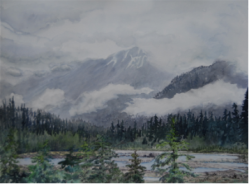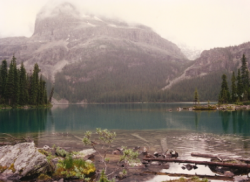A Parade of Skunks
Men With Guns
When Carol and I were both living in Alberta, we stayed a month at the Gushul Studio for Artists in Blairemore, Alberta. The town was near Frank Slide, the tragic site of a small coal mining community crushed by a mountain slide. The area felt eerie to begin with. It was late spring, and some snow was still on the mountains. We decided to take a small road off the beaten track. We found a very isolated spot to set up. “What should we do if a bear or somebody comes out of the woods with a gun?” I asked, out of the blue. Carol looked at me as if I were crazy. She replied, “We hop in the car and lock the doors.” Wouldn’t you know it? We heard a gun shot. Was I having psychic experience? We looked at each other in disbelief. Two men with rifles walked out of the woods saying they were out shooting gophers. Instead of hopping in the car we stood there like idiots and nervously giggled. They explained that their vehicle was stuck in the snow. “Can you give us a shovel and a lift into town?” they asked. It is difficult to say no to men holding guns. “We will, but you have to wait until we finish painting and the guns have to go in the back of the van,” I said. After listening to them shooting gophers while we painted, we worked ourselves into a panic and decided we were doomed. Once in town, and feeling very traumatized, we headed straight for the ice cream parlor.

Unpredictable Weather
Together with my sisters Rebecca Perehudoff, and Carol Perehudoff, and my mother, Dorothy Knowles, I have had many adventures in search of new landscapes to paint. We have met unconventional people, encountered wildlife, and experienced unpredictable weather. Recently, Mom was saying it always seemed that if we started out in sunshine we would be painting in the rain and if we started with grey skies we spent the trip in the sun. Our quest to seek out scenery and new motifs took us to quite a few provinces and as well into the United States. Initially, we travelled within Saskatchewan, either heading up north or venturing south to the Regina Plains, Qu’Appelle Valley, or Cypress Hills.


Cypress Hills, Saskatchewan
Calgary artist, Barbara Ballachey, would invite Rebecca and me along with other landscape painters such as Catherine McAvity out to her family’s ranch adjacent to the forestry reserve along the foothills. There we could meander through the woods, walk across streams, admire the horses, and paint.
We also headed west into the mountains. My sister Carol, who is now a writer, was with Mom and I, on one of our first trips through Jasper, Alberta. It was April and along every road south of Jasper there were avalanche warnings. We later thought that perhaps it wasn’t prudent to pick that time of year, but the colours were amazing. Mom commented, “They looked like blue china.”
Many legendary artists such Canadian J.E.H. MacDonald, and Arthur Lismer, both of the Group of Seven, have painted Lake O’Hara in British Columbia. During one particular trip, I went with my parents and the weather was cool and wet with the clouds hugging the mountains. The lake was captivating and the wilderness, thrilling.


Lake O'Hara, British Columbia
Journal Excerpt from July 2, 1992
“Mom and I painted Lake O’Hara while sitting on red wool blankets and a bench at the end of the lake. By lunch, it had begun to drizzle. We could only get the tiniest sketches done. Fortunately, after lunch, the clouds lifted and we were able to hike and take photographs. The next morning we saw the mountain peaks for the first time. The sun was out, at least briefly. We painted by the lake having our trusty umbrellas ready for the rain that came every 30 minutes. We later hiked to Morning Glory Lake but not before I had pulled a muscle in my neck and couldn’t turn my head. The trail was rocky and treacherous. I was worried about injuries and bears. We made it to the lake where there was an alpine meadow at the bottom of a glacier. The mosquitoes were terrible. We paused momentarily to witness the splendor and the blooming flowers. We were exhausted upon arrival and discovered that Dad had been on a two-hour hike by himself. I was so glad we were all safe.”
Elbow Falls, which is west of Calgary in Kananaskis Country, was a favorite destination. Artist Laurel Cormack and I drove there from the Leighton Centre, which was 15 kilometers southwest of Calgary.
Journal Excerpt from June 7, 1991
It seemed to take forever to get to Elbow Falls. We set up late in the morning and by 3:00 p.m. I felt my painting was really starting to look good. Suddenly the wind blew my easel over! The painting hit a charcoal log and gravel and was immediately destroyed. This happened just as I had turned around to get fresh water. The timing was unbelievable. Salvaging what I could, I kept painting when it started to rain. It was pouring so hard we couldn’t even see through the windows of our vehicle.
Vans – The Vehicles of choice for Landscape Painters
 After she had moved to Calgary, my sister, Rebecca, often joined Mom and I, on our sketching trips that were fruitful and productive excursions. We painted continuously until dusk and photographed every site. The photographs and watercolors gave us the information, studies, and inspiration for the work eventually done in the studio. Initially, my mother had a blue Chevy van. If the weather was bad, we were able to sit inside and paint. Painting without distractions or interruptions meant that we could really focus and our facility as painters was enhanced. Sometimes we were rained on, or woke up to snow but we were determined and just kept driving, stopping, and painting. It was fascinating to see how we each chose a different aspect of the landscape to be our subject matter. Mom often said one should look for something exquisite and then turn around and paint the other direction. This stemmed from something Washington based critic, Andrew Hudson, had told her, that Renoir would set up a still life and then turn it around and paint the other side. One spring, my mother bought a Volkswagen camper van. This was perfect. We would no longer have to search for motels and restaurants in out of the way places. We could paint, cook, and sleep in the van. It also had screens on the windows so we could paint sitting inside it when the mosquitoes or flies were bad and not find it unbearable on a hot day.
After she had moved to Calgary, my sister, Rebecca, often joined Mom and I, on our sketching trips that were fruitful and productive excursions. We painted continuously until dusk and photographed every site. The photographs and watercolors gave us the information, studies, and inspiration for the work eventually done in the studio. Initially, my mother had a blue Chevy van. If the weather was bad, we were able to sit inside and paint. Painting without distractions or interruptions meant that we could really focus and our facility as painters was enhanced. Sometimes we were rained on, or woke up to snow but we were determined and just kept driving, stopping, and painting. It was fascinating to see how we each chose a different aspect of the landscape to be our subject matter. Mom often said one should look for something exquisite and then turn around and paint the other direction. This stemmed from something Washington based critic, Andrew Hudson, had told her, that Renoir would set up a still life and then turn it around and paint the other side. One spring, my mother bought a Volkswagen camper van. This was perfect. We would no longer have to search for motels and restaurants in out of the way places. We could paint, cook, and sleep in the van. It also had screens on the windows so we could paint sitting inside it when the mosquitoes or flies were bad and not find it unbearable on a hot day.
My sisters and I also bought vans for outdoor painting. Not everybody seeing us out painting beside or in our vans understood we were artists. On one occasion while Rebecca painted near a ranch outside the city of Calgary, the rancher drove up, approached her, and checked to see if she was poaching cattle!
Collector Invitation
For archival purposes and future public exhibitions the artist would like to invite collectors of her work, if they are interested, to share their names, the title, medium, year of the painting they own and contact information with her in order to facilitate potential curatorial research. Due to the closing of many commercial galleries previously exhibiting her work information pertaining to the location of earlier paintings has been lost. This information would be kept confidential in the artist’s records unless there was a request for a specific art work to be included in a public exhibition at which time the collector would be contacted for permission.
